By Aaron Goings
Via Raccoon
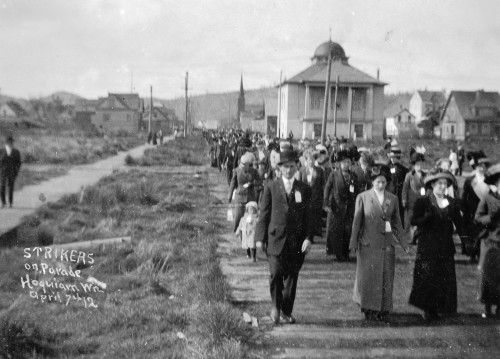
Grays Harbor is as an inviting starting point for a history of Industrial Workers of the World (IWW or Wobblies) in the Pacific Northwest because any study of this region should place this militant revolutionary organization and the dramatic labor confrontations it waged at or near the center. This contention rests in part on the fact that in Grays Harbor literally thousands of workers joined or otherwise supported the IWW during the first four decades of the twentieth century.
The region also experienced a series of epic labor struggles, frequently led by the IWW. With some notable exceptions, Grays Harbor’s radicals hailed primarily from the lumber industry, working in this dirty, dangerous industry as loggers, lumber and shingle mill laborers, longshoremen, sailors, and logging camp waitresses. These men and women formed a diverse array of working-class organizations and political parties to fight their bosses, improve wages and working conditions, push government in more worker-friendly positions, and in some cases to overthrow the capitalist system.

Grays Harbor occupies the Southwest corner of Washington’s Olympic Peninsula. The Harbor towns, the term used for the region’s main urban centers of Aberdeen, Hoquiam, and Cosmopolis, were carved out of the forests and mud between the 1880s and 1910s, built alongside the numerous rivers that empty into the harbor. These abundant evergreen forests also provided the region with its main industries. Logging, lumber, shingles, and the shipping of wood products employed tens of thousands of workers during the early twentieth century. Local laborers produced and shipped lumber on an epic scale. Harbor mills regularly cut the most lumber of any place in the United States, while the region’s teamsters, longshoremen, and sailors were responsible for shipping record-breaking amount of lumber annually, earning the region its annual title as “Largest Lumber-Shipping Port in The World.” In 1924 Grays Harbor became the first port to ship out over a billion board feet of lumber by water, a feat that earned heavy praise of local boosters: “Grays Harbor would be the only lumber port in the world able to talk in billions while others were talking millions in the lumber game.”[1]Thousands of men and women labored in Grays Harbor’s lumber industry during the early twentieth century, performing the work necessary to allow the region’s industry to reach such impressive heights. Early twentieth century lumber workers labored long hours in treacherous conditions for low wages. Until strikes led by the IWW forced Pacific Northwest lumber employers to grant the eight-hour day, lumber workers worked ten hours per day as a rule. During the first three decades of the twentieth century, loggers died at a much higher rate than any other job on the Pacific Coast. Lumber manufacturing was the second most dangerous occupation in the region, while shingle weavers regularly lost fingers, hands, and arms to the swirling saws. Most Pacific Northwest loggers spent their entire adult lives aware that they would meet their fate in the woods. Finnish-American logger Max Wilson recalled there being “49 different ways to get killed in the woods,” and during one year logging for the Aloha Corporation, he recalled, “they must have killed about five men.”[2]
Despite the long hours and dangerous working conditions, mill laborers received only a paltry compensation for their work. Aberdeen mill hands earned an average of between $1.75 and $2 per day in the decade between 1900 and 1910.[3] By comparison, the daily wages earned by unionized Grays Harbor hod carriers, carpenters, and printers were $3.50, $3.60, and 4.50 respectively.[4] Dr. Herman Titus, a prominent Washington State socialist, visited the Harbor and described the living conditions of the lumber workers’ families. He wrote, “I have seen children — sons and daughters of the working mill hands — come to the back yard of the hotel and pick old scraps of meat and bread from the garbage cans.”[5] The bare subsistence wages earned by mill hands even made an impression on notoriously anti-union employers like W. B. Mack, manager of the Slade mill in Aberdeen. During a lumber strike in May 1909, he admitted: “It is practically impossible to live on $1.75 a day.”[6]
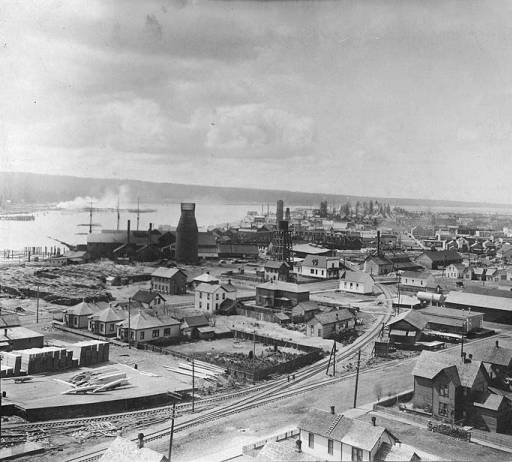
The IWW found strength among Grays Harbor’s immigrant workers who struggled to survive in an industry where low wages, long hours, and dangerous working conditions were the rule.Thousands of immigrants joined thousands more native-born workers to perform the paid and unpaid labor that enabled Grays Harbor to become the world’s lumber capital. Aberdeen, Hoquiam, and Cosmopolis each had their own ethnic communities, complete with a diverse array of immigrants and immigrant families, immigrant-owned institutions such as restaurants and newspapers, and rich sets of social and cultural activities based, as often as not, around the group’s meeting halls. After 1900, the Finnish-American community grew to become the region’s largest as thousands of Finns settled in nearly all of Grays Harbor’s cities and towns. The group’s numbers were greatest in Aberdeen and Hoquiam, the so-called “twin cities” of Grays Harbor, whose workforce was responsible for producing and shipping an average of more than one billion board feet of lumber annually during the 1920s. More than 2,000 first- and second-generation Finns settled in Aberdeen and Hoquiam by 1920. A second, although much smaller, concentration of Finnish immigrants settled in Grayland, a beach community numbering approximately 200 residents – more than half of them Finns – during the 1920s and 1930s.
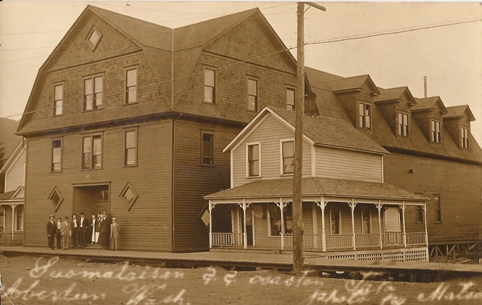
During the first decades of the twentieth century, Grays Harbor had one of the most densely unionized workforces in the Pacific Northwest. Still, the local trade union movement did not represent the local working class as a whole. Instead, the dozens of craft unions that comprised the movement during its first dozen years were designed to represent a small group of privileged workers in selected industries. African Americans, Native Americans, Asian Americans, women, and so-called “new immigrants” who hailed from southern and eastern European nations, represented only a small minority of union members.[7]
The IWW stepped into the vast void created by the region’s trade unions, promising to organize workers regardless of race, sex, or skill. But the Wobblies were not merely more open (or “industrial”) versions of AFL-style craft unions. Instead, the Wobblies were (and are) committed to challenging capitalism itself, working to break the chains of industrial bondage. In June 1905, a collection of socialists, anarchists, militant unionists, and other labor radicals met in Chicago to found the Industrial Workers of the World (IWW), an industrial union (a term that contrasted with “craft union” and meant a union that included unskilled workers as well as skilled craft workers) and a revolutionary organization. The IWW hoped to organize all workers, regardless of race, sex, or skill, into “One Big Union.” They advocated for workers to use direct action on the job, such as strikes, sabotage, and slowdowns, rather than political or electoral action. Wobblies understood that capitalism is an inherently exploitative system, one in which workers and employers are locked in a perpetual struggle in which both sides seek to gain at the other’s expense. In other words, the Wobblies understood that workers desire the full fruits of their labor, while employers want a free hand to extract as much wealth as possible.
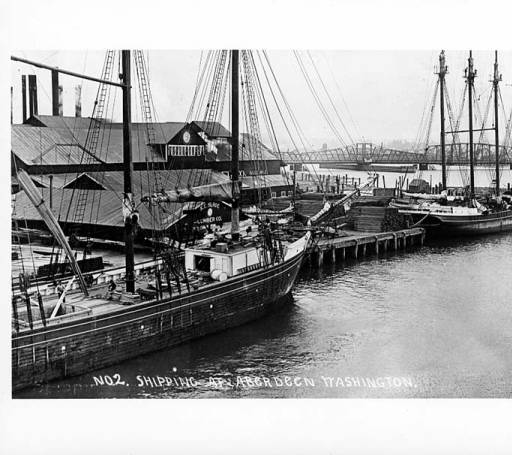
In Grays Harbor the Wobblies organized primarily among lumber workers, establishing their first local in Hoquiam in early 1907. The local IWW grew dramatically during the Aberdeen Free Speech Fight of November 1911 to January 1912, when IWWs joined Harbor socialists in their successful efforts to overturn a municipal law banning left-wing political speeches in Aberdeen’s downtown. Efforts by Wobblies to establish a stronghold on the Harbor triggered a six-month-long coordinated attack on the radicals by Grays Harbor employers and agents of the state. Employers formed citizens’ committees – members hailed from local chambers of commerce – in Aberdeen and Hoquiam to disrupt and remove the IWW presence on the Harbor. The vigilante groups arrested and jailed activists, used fire hoses to disperse their meetings, sought to “starve out” strikers by refusing them credit at local merchants, imposed exorbitant fines for minor criminal offenses, deported activists from town, violently assaulted them with clubs and firearms, and raided and closed their halls. The Hoquiam Citizens’ Committee armed itself with shotguns and clubs, and formed a cavalry to ride down the strikers.
The Harbor Wobblies’ free speech fight won them national attention. For two months, news from Grays Harbor ran across the front page of the Industrial Worker. By January 1912, local IWWs had more than one hundred free speech fighters prepared to violate the ordinance and go to jail and face other forms of punishment. Faced with this determined opposition, Aberdeen municipal officials compromised with the IWWs. The city council passed a new ordinance that allowed street speaking without a permit on most of Aberdeen’s major city streets.
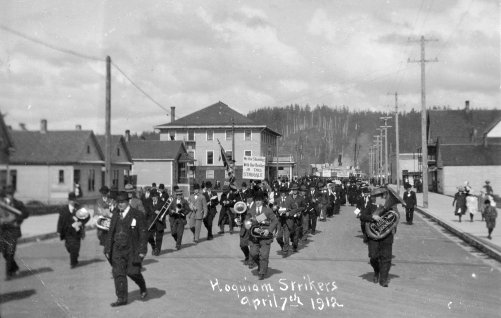
Within a month of the repeal of the speaking ban, Grays Harbor workers had formed three Wobbly locals, which hosted nightly street meetings and weekly hall lectures. In the Spring of 1912, fresh from their free speech fight victory of the Wobblies struck alongside militant immigrant lumber mill laborers in a conflict that Bruce Rogers appropriately called “The War of Gray’s Harbor.” Between March and May of 1912, thousands mill hands and loggers from Grays Harbor, Willapa Harbor, and the Puget Sound joined the strike, eventually shutting down dozens of operations throughout Western Washington. Longshoremen, shingle weavers, sailors, and electrical workers all struck alongside the mill hands. The immediate cause of the conflict was the low wages paid at the Harbor’s mills. One spokesman for the workers declared: “I have seen children—sons and daughters of the working mill hands—come to the back yard of the hotel and pick old scraps of meat and bread from the garbage cans. It is a living wage that the mill hands want, and they will get it.”[8]
The strike mobilized a multi-ethnic community behind the cause of the mill workers. On March 23rd, two parades, each a “half mile long” and fronted by women and members of the Finish socialist band, converged at Electric Park on the border of Aberdeen and Hoquiam. Thousands of striking workers and supporters presented a united front against Harbor employers in what was shaping into a region-wide general strike. Near the crowd’s center, atop a “large box,” rose an illustrious lineup of “speakers in many different languages.” Workers listened to a long series of speeches, sang and played “revolutionary music,” and carried signs reading: “We Are Striking for Living Wages.” Within a week of the initial walkout, strikers were “coming into the I.W.W. at the rate of from 125 to 150 daily, in Aberdeen alone.”
In the face of this workers’ revolt, employers, police, and labor spies again resorted to mass arrests, deportations, and beatings. Banker William J. Patterson, the head of the Aberdeen Citizens’ Committee, described the group’s actions: “we organized that night a vigilante committee – a Citizens’ Committee, I think we called it – to put down the strike by intimidation and force. . . . [W]e got hundreds of heavy clubs of the weight and size of pick-handles, armed our vigilantes with them, and that night raided all the IWW headquarters, rounded up as many of them as we could find, and escorted them out of town.”[9] In Aberdeen, between November 1911 and May 1912, citizens’ committee members and police deported scores of IWWs from town; a group of 150 more only narrowly escaped being shipped out of town in a boxcar by the timely intervention of workers from the Northern Pacific railroad. One Wobbly editorialist wrote, “The lumber strike at Grays Harbor presents a scene that resembles a composite photograph of the atrocities at Lawrence, Mass., and the barbarities at San Diego, Cal.”[10]
One result of the strike was that it contributed to the trend of local leftists shifting ideologically from parliamentary socialism towards revolutionary syndicalism. Of the hundreds – if not thousands – of Grays Harbor workers who joined the IWW in 1912, many retained an informal affiliation with the Wobblies, one that they revived four years later when local workers again organized themselves into IWW branches.
The Wobblies were strongest in Grays Harbor between 1917 and 1923. In the cities, logging camps, and beach communities, they organized domestic workers, loggers, construction workers, clam diggers, mill hands, longshoremen, and sailors. As was often the case, the Harbor Wobblies gained their greatest following among the large Finnish-American population. Between 1917 and 1939, the names of several hundred Finnish Wobblies from the Grays Harbor region appeared annually in the pages of the Industrialisti, the Finnish-language newspaper of the IWW.
In the midst of World War I, the Wobblies led Pacific Northwest workers in what was the largest lumber strike in U.S. history up to that point. Seeking to force employers to grant the eight-hour day and improve working conditions, IWWs and other unionists struck and paralyzed the Pacific Northwest lumber industry. In Grays Harbor the Wobs shut down all but one firm: the notorious Grays Harbor Commercial Company at Cosmopolis, a mill referred to as “the Western penitentiary” by unionists.[11] In mid-September the Wobblies took their strike “back on the job,” the radicals’ term for returning to work but utilizing a variety of tactics – slowing down, feigning ignorance of work processes, closely following safety regulations – in order to minimize production. Striking “on the job” had many advantages for the Wobblies. With workers on the job, securing scabs was made more difficult, and it enabled the “strikers” to continue to be paid while taking direct action in pursuit of higher wages and improved work conditions.
The strikers won higher wages and shorter hours at mills and logging camps throughout Grays Harbor and the wider Pacific Northwest. Summing up the IWW’s successes, Wobbly James Rowan concluded: “The strike was over. The organized power of the lumber workers had won against one of the most powerful combinations of capital in the world. Two hours had been cut from the work day, wages had been raised, and conditions in the camps improved one hundred per cent. The lumber barons claimed they had granted the eight hour day ‘voluntarily,–for patriotic reasons.’ In reality they had granted nothing. All they had done was to give the eight-hour day their official recognition, after it had been taken by the direct action of the lumber workers themselves. There was nothing else they could do.”[12]
The hard-fought wartime gains made by the IWW came at a bitter price. Patriotic clubs, strikebreakers, and hoodlums attacked prominent IWW speakers, rank-and-file Wobblies, and the group’s halls and meetings. In his book The Centralia Conspiracy,Wobbly Ralph Chaplin related news that a band of 4Ls lynched an IWW near the Grays Harbor County seat of Montesano. Chaplin spent ample time on the Harbor conducting research for The Centralia Conspiracy, about the 1919 Armistice Day Tragedy in Centralia. When a group of vigilantes tried to disrupt Chaplin’s 1919 speech in Aberdeen and menace the IWW Hall, large numbers of Wobblies and their supporters turned out to defend Chaplin and the Hall. He recalled that in response to this threat, each Wobbly “was armed with a loaded baseball bat.” According to Chaplin, 2,000 Wobblies and sympathizers turned out to defend him from the vigilante mob. One of the armed Wobblies warned Chaplin that “there’s going to be hell-popping” and “we don’t want you in on it. You’re married and have a long sentence hanging over your head already.” All told, noted Chaplin, two thousand workers turned out to protect the Aberdeen Wobbly hall.[13]
Employers and police clearly understood the significance of the radicals’ halls. Aberdeen vigilantes raided or destroyed IWW halls in Aberdeen and Hoquiam on multiple occasions between 1911 and 1922. In April 1918, state agents and local vigilantes “swarmed” into the Aberdeen hall, tore the sheathings from the hall, stole and destroyed the furniture, fixtures, a typewriter and phonograph, as well as the suitcases, blankets, calked boots, and other goods left by workers in the hall, all of which the vigilantes used to build “a ‘Liberty Loan’ bonfire in the street.”[14]
While hall raids and beatings proved popular among anti-radicals, employers’ best tools for fighting against the Wobblies proved to be federal and state-level legislation, particularly the Washington State criminal syndicalism law. Passed in early 1919, the law essentially made membership in the IWW illegal. Dozens of IWWs were arrested in Grays Harbor between November 12, 1919, and April 5, 1920. The dubious honor of being the first criminal syndicalism victim on the Harbor fell to Charles Riddle, a “logger transient,” whose crimes of being “suspected of being an IWW” and blaming the “capitalist class” for the Centralia tragedy earned him time in the county lockup.[15] In an attempt to gain guilty verdicts, prosecutors brought in professional witness and former Wobbly A. E. Allen, who testified about his knowledge of IWW death threats against public officials, the destruction of property, and “slacking on the job . . . during war days.”
Criminal syndicalism prosecutions continued in Grays Harbor for the next four years: eleven in 1919, six the next year, fifteen in 1921, while in 1922, the last year of its enforcement in the county, twenty-three IWWs were arrested for violations of the statute. Criminal syndicalism arrests were so widespread that a November 1922 issue of the Grays Harbor Post could boast that: “There have been prosecutions and convictions of IWWs during practically every jury term in the past two years.”[16]
In spite of this intense persecution, organization in Grays Harbor continued in haste. From 1921-1923, Grays Harbor Wobblies joined fellow workers across the United States by increasing their public actions, organizing repeated displays of power designed to challenge obnoxious laws, liberate their imprisoned fellow workers, and win bread-and-butter gains on the job. One aspect of the local Wobblies’ early 1920s revival was the formation of the Foodstuffs Workers’ Industrial Union (FWIU) 460, a local comprised of women and men, and organized primarily by Finnish-American immigrant women in Aberdeen during 1923.[17] The Wobbly activist Jennie Sipo, a one-time criminal syndicalism prisoner, served as the union’s organizer and headed the list of the union’s charter members.
In 1922-1923, IWW membership around the nation climbed precipitously. In late-1922, Wobblies laid an ultimatum at President Warren G. Harding’s doorstep: Either release all class war prisoners held in federal and state penitentiaries or face a general strike. The threatened strike was set to begin on May 1, the International Workers’ Day. At this point, 20 IWWs still awaited their release in the Washington State Penitentiary. Another 49 were held at the federal penitentiary in Leavenworth, Kansas.
On April 25, 1923, the Industrial Worker ran a giant headline reading: “Strike One –Strike All!”[18] Workers throughout the nation had already begun to pour off the job. Grays Harbor was one of the centers of strike activity. At the start of May, loggers had shut down at least forty camps. One Wobbly wrote that there were “30 or 40 men in each mill, distributing hand bills and talking to the workers as they come off the job.”[19] All told, approximately 4,000-5,000 Grays Harbor mill workers, loggers, longshoremen, and clam diggers struck to free class war prisoners in late-April and early-May 1923.
Determined to spread the strike, workers marched to Aberdeen’s Bay City mill where they set up informational pickets outside the mill gates. One the picketers was IWW logger William McKay. When McKay and his fellow workers arrived at the gate, company gunman E.I. Green met them. According to one witness, Green “was standing a short distance away [from the pickets], loudly taunting the crowd of men with abuse and vile language, including in his remarks something to the effect that no one belongs to the Industrial Workers’ Union but foreigners who cannot speak English.”[20] Outraged at the taunt, McKay stepped forward shouting: “Do you mean that for me?” During the quarrel, Green pulled his revolver and McKay, seeing the weapon, attempted to flee. As McKay ran, Green shot McKay in the back of the head, killing him.[21]
Wobblies took to the streets to commemorate McKay’s life. More than 1,000 working people marched from the funeral parlors in downtown Aberdeen to the cemetery in a massive funeral parade. Wobs carried a giant banner reading: “Fellow Worker McKay: Murdered at Bay City Mill by a Co Gunman May 3rd 1923. A Victim of Capitalistic Greed. We Never Forget?” While the IWW demanded Green’s prosecution, no one was ever brought to justice for McKay’s murder.[22]
The funeral parade of William McKay was among the last large-scale demonstrations by the IWW in Grays Harbor. But 1923 did not mark an end to the Wobblies in Grays Harbor. In early November 1924, Finnish-American Wobblies celebrated the completion of a massive hall in east Aberdeen’s “Finn Town.” Construction costs for the hall – called the New Finn Hallor IWW Finn Hall – were approximately $25,000. The finished product included an auditorium, theater stage, balcony, library, business offices, restaurant, and apartments. The weekend’s activities bespoke the local character of the IWW movement culture as it existed on the Harbor during the 1920s and early 1930s. Tie Vapauteen (Road to Freedom), the IWW’s monthly Finnish-language magazine, reported that those in attendance witnessed a play, a banquet, a dance, poetry recitals, and political speeches. The magazine also published a poem by Grays Harbor Wobbly Antti Maki entitled “Puolesta Joukon Miljoonaisen” (On Behalf of A Group of A Million Strong) that demanded “freedom for slaves” even “if we must purchase it with blood.”[23]
From the hall’s opening until the local union withered into obscurity more than a decade later, Wobblies remained active contributors to the local radical culture, persisting in Grays Harbor while much of the IWW’s national membership withered. They maintained many of their fundraising and social activities, and appeared by the hundreds in the annual Industrialisti list of IWW members and supporters. The hall provided large spaces where they performed working-class theater and concerts; held dances, entertainments, and dinners were held; housed a multi-lingual library; and forged an IWW movement culture built by workers of diverse races and ethnicities.
While much of the Grays Harbor IWW’s focus centered among the region’s Finnish-American population and most 1920s and 1930s Wob activities took place within the relatively security of its hall, local IWWs continued to engage in workplace and wider community struggles. In 1924, the Lumber Workers’ Industrial Union (LWIU), with a large and active membership in Grays Harbor, claimed more members than any other IWW industrial union. Between 1923 and 1930, Grays Harbor Wobblies formed and maintained locals of the LWIU, Marine Transport Workers’ Industrial Union (MTWIU), General Construction Workers’ Industrial Union, and Foodstuffs Workers’ Industrial Union (FWIU). Harbor Wobblies formed several auxiliary organizations that provided financial and moral support for local and national IWW activities. To gain funding and readership for the Wobbly newspapers, Harbor radicals completed in subscription sales contests and established an IWW auxiliary called the Industrialisti Support Circle. To raise money for the defense and support of political prisoners, Harbor IWWs hosted dances, picnics, and mass meetings featuring prominent radical speakers. As late as 1931, the group hosted lotteries to help fill its coffers. Young Wobblies formed their own organizations and sponsored their own social activities. The Grays Harbor IWW sponsored a band, choir, theater troupe, and athletic club, while during strikes Harbor IWWs formed their own relief and medical committees.
Local Wobblies also came out of their halls and onto picket lines to protest low wages and inadequate relief services during the Great Depression, saloons that served alcohol during strikes, and the continued imprisonment of IWW political prisoners jailed during the Red Scare. Still, the Harbor Wobblies were not immune from the changes taking place among the nation’s left-wing movements, nor could they hide from lumbermen’s and other employers’ mostly successful efforts to bolster production and bust unions during the 1920s. With its base shifted into its halls and thus away from its members’ workplaces, the once-potent Grays Harbor lumber workers’ movement splintered into several competing groups affiliated with the IWW, AFL, CIO, Communist Party, and several independent union organizations. By the middle of the 1920s, the groups directing the majority of lumber and maritime workers’ activism lay largely outside of IWW control, as the Wobblies split into two competing organizations; Communists channeled new resources into organizing on the Pacific Coast; a large body of Finnish socialists shifted allegiance, becoming part of the Communist movement; and employers continued to stymie worker organization through a combination of paternalistic welfare programs and repressive measures such as labor spying and blacklists.

Copyright (c) Aaron Goings, 2016

Aaron Goings is associate professor of history at Saint Martin’s University in Lacey, Washington. During the 2014-2015 academic year, he worked as a Fulbright Scholar at the University of Jyväskylä in Finland. His first book, (co-authored with Gary Kaunonen) Community in Conflict: A Working-Class History of the 1913-14 Michigan Copper Strike and the Italian Hall Tragedy, (Michigan State University Press, 2013) won the 2013 Outstanding History Publication from the Michigan Historical Association. This article is part of a larger book manuscript on the radical and labor history of Grays Harbor, entitled “Radicals in the Community: Workers, Community, and Class Mobilizations in Grays Harbor, Washington, 1890-1940.” He can be reached at agoings@stmartin.edu.
[1] The quotation appeared in the Grays Harbor Washingtonian (Hoquiam, WA).Cited in John Hughes and Ryan Teague Beckwith, ed., On the Harbor: From Black Friday to Nirvana (Aberdeen, WA: The Daily World, 2001), 72; Fred Lockley, “Grays Harbor: The Largest Lumber-Shipping Port in the World,” Pacific Monthly 17:6 (June 1907): 721.
[2] Maxwell Wilson, interviewed by Donald L. Myers, Nov. 26, 1975, Washington State Oral/Aural History Project, 22.
[3] Aberdeen Daily Bulletin, July 18, 1905; Aberdeen Herald, July 22, 1905; Grays Harbor Post (Aberdeen, WA), May 29, 1909.
[4] State of Washington, Seventh Biennial Report of the Bureau of Labor Statistics and Factory Inspection, 1909-1910 (Olympia: C. W. Gorham, Public Printer, 1908), 47, 55, 72.
[5] Aberdeen Daily World, March 15, 1912.
[6] Grays Harbor Post, May 29, 1909.
[7] Philip S. Foner, The History of the Labor Movement in the United States, Vol. 3, The Policies and Practices of the American Federation of Labor, 1900-1909, Fourth Printing (New York: International Printers, 1981), 256-259.
[8] Aberdeen Daily World, March 15, 1912.
[9] Robert Walter Bruere, Following the Trail of the IWW: A First-Hand Investigation into Labor Troubles in the West — A Trip into the Copper and the Lumber Camps of the Inland Empire with the Views of the Men on the Job (New York: New York Evening Post, 1918), 19.
[10] Industrial Worker (Spokane), April 18, 1912.
[11] Robert Weinstein, Grays Harbor, 1885-1913 (New York: Penguin Books, 1978), 19.
[12] James Rowan, The IWW in the Lumber Industry (1920; reprint, Seattle: The Shorey Book Store, 1969), 54.
[13] Ralph Chaplin, The Rough-and-Tumble Story of an American Radical (Chicago: University of Chicago Press, 1948), 290.
[14] Industrial Worker (Seattle), April 8, 1918; Robert L. Tyler, Rebels of the Woods: The IWW in the Pacific Northwest (Eugene: University of Oregon Press, 1967), 129; Tom Copeland, The Centralia Tragedy of 1919: Elmer Smith and the Wobblies (Seattle: University of Washington Press, 1993),31.
[15] Aberdeen Daily World, Nov. 12, 13, 1919; Feb. 10, 1920.
[16] Grays Harbor Post, Nov. 4, 1922.
[17] Charter, Aberdeen Branch of Industrial Union 460, Industrial Workers of the World Papers, 26 October 1923, Box 17, Folder 4, Walter P. Reuther Library, Wayne State University, Detroit, MI (hereafter WSU).
[18] The Strike Call For April 25, 1923, Industrial Workers of the World Collection, Box 46, Folder 28, WSU; Industrial Worker, April 25, 1923.
[19] Industrial Worker, May 5, 1923.
[20] Industrial Worker, May 16, 1923.
[21] Industrial Worker, May 16, 1923; Seattle Union Record, May 4, 1923; Seattle Times, May 4, 1923; Bellingham Herald, May 4, 1923.
[22] Industrial Worker, May 16, 1923; John Hughes and Ryan Teague Beckwith, ed., On the Harbor: From Black Friday to Nirvana, ed. John C. Hughes and Ryan Teague Beckwith (Aberdeen, WA: The Daily World, 2001), 42; Seattle Union Record, May 5, 1923; Aberdeen Daily World, May 8, 1923.
[23] Antti Maki, “Puolesta Joukon Miljoonaisen,” Tie Vapauteen (November 1925): 7-8, trans. Jenni Salmi.